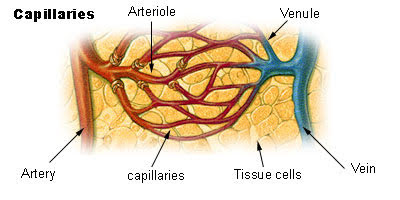
In the body oxygen is transported through the blood vessels.
Oxygen-rich blood from the lungs is circulated by the heart to the brain and the rest of the body by large arteries. These arteries split and get smaller. At the place of destination (in the body) there should be a transfer taking the place of oxygen and nutrients. The blood flow may, of course, not be too fast, otherwise this transfer does not take place. Because the arteries so frequently have split and ever have narrowed blood eventually flows very slowly. The small vessels where this transfer of oxygen and nutrients takes place are the capillaries (capillaries). Eventually it becomes oxygen-poor blood again collected in small vessels which come back together and get bigger; the veins. The veins transport the oxygen-poor blood back to the heart.
A capillary malformation is a deviation from the capillaries. These vessels are then usually widened, making you the typical color of this skin condition. A capillary malformation is a slow-flow vascular malformation. Examples include the Wine Stain(Nevus flammeus), Stork bite and Cutis Marmorata Telangiectatica Congenita (CMTC).
Capillary malformations are common skin conditions that appear as pink or red marks on the skin, often present from birth. These marks are caused by an abnormal arrangement of small blood vessels under the skin. While all these marks fall under the general term “capillary malformations,” they can look very different. In recent years, we have learned that these differences are due to mutations that occur in vascular cells during embryonic development. Depending on the timing of the mutation, the number of affected cells, the location of the mutation, and many other factors, capillary malformations can appear in various forms. Many genes can be involved, such as GNAQ, GNA11, PIK3CA, PIK3R1, KRAS, RASA1, EPHB4, and AKT3.
Differences in Appearance:
Capillary malformations can vary widely in how they look:
Why Recognizing These Differences Matters
Although all vascular birthmarks are called capillary malformations, distinguishing them based on their appearance has several benefits:
Different Types of Capillary Malformations
Available Treatments
Treatment options vary depending on the type and severity of the capillary malformation. Common approaches include laser therapy to lighten port-wine stains and medications to manage associated health issues. Early diagnosis and personalized care are essential to improving outcomes and quality of life.
In Summary: There is not a single type of capillary malformation, but many.